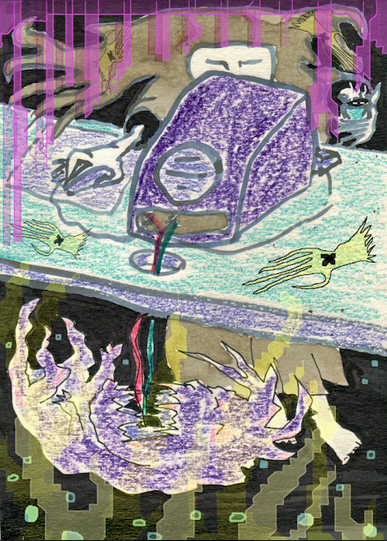UMA BREAKDOWN, United Kingdom
they/them
media artist I media theorist I writer research
www.umabreakdown.com
are based in Gateshead (UK) with a special interest in queer horror literature and cinema, non-human agency, video games, and Feminist Post-Structuralism. They are disabled and trans* non-binary.
Their art practice, writing, and research overlap considerably, as do the forms outputs take, crossing the lines of fiction, theory, lecture, publishing, radio play, performance, games, diagrams, paintings, and video.
The navigation of space implied vectors, and hidden voids are concepts that are key to their research and artist practice. For example: Drawing from the first of their key readings below, they have used Mary Flanagan's analysis of 3D game space exploration as production of subjectivity. Specifically, they are interested in how the creative process of moving through game space can be understood through Hélène Cixous’s enmeshed theories of writing, reading, and the creation of subjectivity. This was a key strand of their PhD, and artistic/game design practice. They have an article at peer review stage applying the concept to Ice-Pick Lodge’s “Pathologic”.
Under present political conditions (as well as those of Covid-19) they feel more strongly than ever that communities such as SIG are vital.
CREDITS AND REFERENCES
1. Photo credit: Uma Breakdown
1.Flanagan, M (2002) Hyperbodies Hyperknowledge: Women in Games, Women in Cyberpunk and Strategies of Resistance, in: Flanagan, M., Booth, A. (eds.) Reload: Rethinking Women and Cyberculture. Cambridge, Massachusetts: The MIT Press
2. Cixous, H. (2005) Three Steps on The Ladder of Writing. New York: Columbia University Press
3. Irigaray, L. (2006) The Natal Lacuna, in: Lotringer, S. (ed.), Edwards, B. (trans.) More & Less 3: : Hallucination of Theory. Fine Arts Graduate Studies Program and the Theory, Criticism and Curatorial Studies and Practice Graduate Programs, Art Center College of Design. Cambridge, Massachusetts, Distribution: The MIT Press, pp. 39-43
